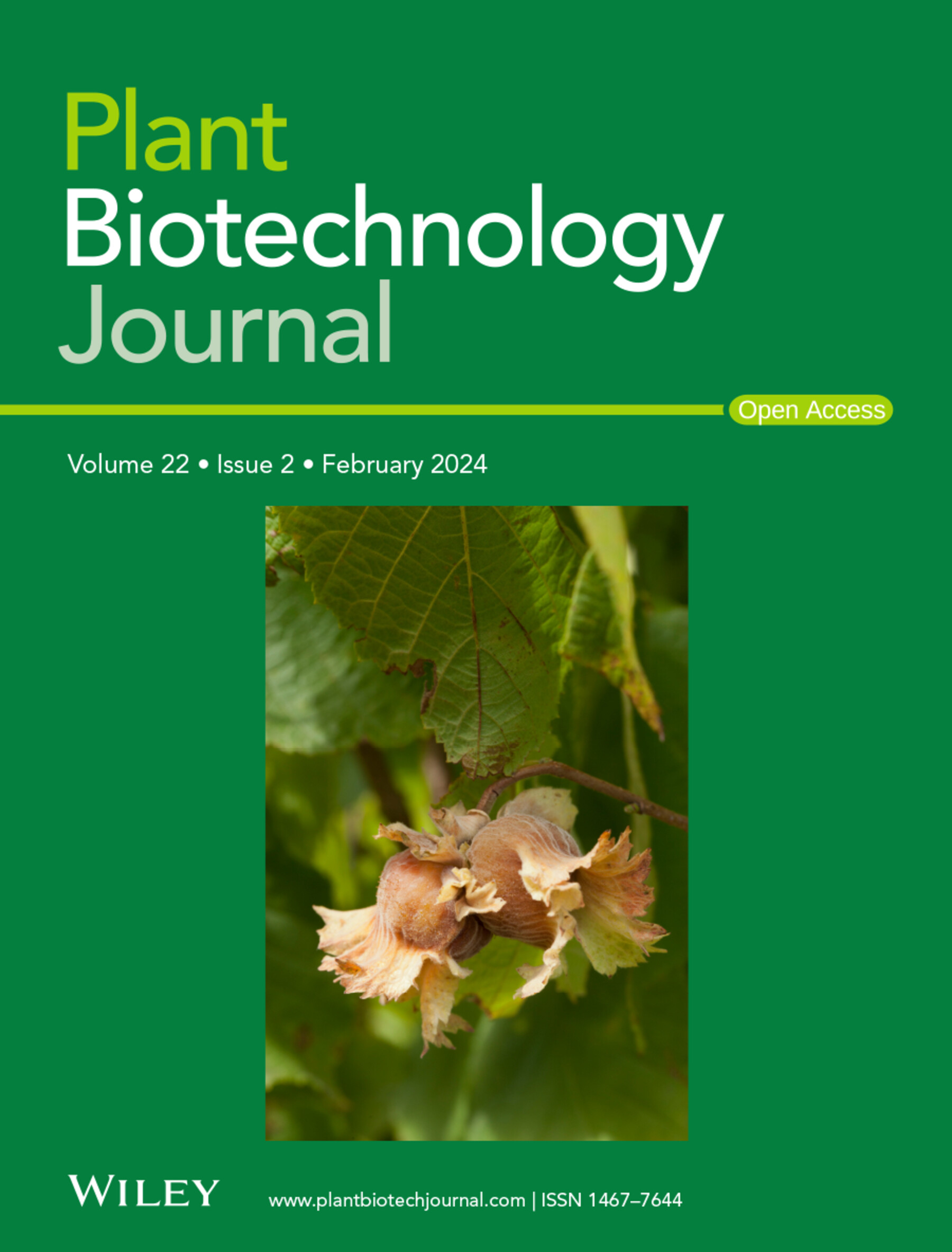涉及miR164a-NACs的抑制激活系统调控桃果组织特异性花青素积累。
IF 10.5
1区 生物学
Q1 BIOTECHNOLOGY & APPLIED MICROBIOLOGY
引用次数: 0
摘要
花青素通常负责水果的颜色,决定其商业价值和提供营养价值。本研究在两个桃品种的果皮、果皮附近的果肉(OF)和果核周围的果肉(IF)中观察到花青素积累的差异。这是由R2R3 MYB转录因子(TF)基因PpMYB10.1的表达驱动的。转录组测序和降解组测序用于鉴定PpMYB10.1上游的调控网络。我们鉴定并功能验证了NAM/ATAF/CUC (NAC) TFs PpNAC22和PpNAC100是花青素积累的激活剂。通过蛋白-蛋白/DNA相互作用实验,发现PpNAC22和PpNAC100均能形成同型二聚体,直接激活PpMYB10.1启动子。降解分析显示PpNAC22和PpNAC100转录本通过miR164a发生裂解。与果皮和OF相比,IF中miR164a的低表达导致PpNAC22和PpNAC100的高表达。功能表征表明,miR164a的过表达显著降低了PpNAC22和PpNAC100驱动的花青素积累。此外,另一种NAC TF PpNAC29被确定间接参与花青素积累的调控。PpNAC29与PpNAC22形成异源二聚体,但不能与PpMYB10.1启动子结合。PpNAC29转录可被PpNAC22和PpNAC100激活,而转录物不被miR164a靶向,揭示了miR164a-PpNAC22/100-PpNAC29级联。该miR164a-PpNAC22/100-PpMYB10.1模块在PpNAC29的辅助下,解释了桃不同果实组织花青素积累的对比。本文章由计算机程序翻译,如有差异,请以英文原文为准。
A Repression-Activation System Involving miR164a-NACs Regulates Tissue-Specific Anthocyanin Accumulation in Peach Fruit.
Anthocyanins are often responsible for fruit colour, determining their commercial value and providing nutritional benefits. In this study, differential anthocyanin accumulation in peel, outer flesh near the peel (OF) and inner flesh around the stone (IF) was observed in two peach fruit cultivars. This was driven by the expression of the R2R3 MYB transcription factor (TF) gene PpMYB10.1. Transcriptome and degradome sequencing were used to identify the regulatory network upstream of PpMYB10.1. We identified and functionally verified that NAM/ATAF/CUC (NAC) TFs PpNAC22 and PpNAC100 are activators of anthocyanin accumulation. Protein-protein/DNA interaction assays were conducted, and it was observed that both PpNAC22 and PpNAC100 could form homodimers to directly activate the PpMYB10.1 promoter. Degradome analysis showed cleavage of PpNAC22 and PpNAC100 transcripts occurred via miR164a. Compared with peel and OF, a lower expression of miR164a in IF resulted in higher expression of PpNAC22 and PpNAC100. Functional characterisation showed that overexpression of miR164a significantly reduced anthocyanin accumulation driven by PpNAC22 and PpNAC100. Furthermore, another NAC TF, PpNAC29, was identified to be indirectly involved in the regulation of anthocyanin accumulation. PpNAC29 formed a heterodimer with PpNAC22, although it could not bind to the PpMYB10.1 promoter. PpNAC29 transcription could be activated by PpNAC22 and PpNAC100 and the transcript was not targeted by miR164a, revealing a miR164a-PpNAC22/100-PpNAC29 cascade. This miR164a-PpNAC22/100-PpMYB10.1 module, with the assistance of PpNAC29, explains contrasting anthocyanin accumulation in different fruit tissues of peach.
求助全文
通过发布文献求助,成功后即可免费获取论文全文。
去求助
来源期刊

Plant Biotechnology Journal
生物-生物工程与应用微生物
CiteScore
20.50
自引率
2.90%
发文量
201
审稿时长
1 months
期刊介绍:
Plant Biotechnology Journal aspires to publish original research and insightful reviews of high impact, authored by prominent researchers in applied plant science. The journal places a special emphasis on molecular plant sciences and their practical applications through plant biotechnology. Our goal is to establish a platform for showcasing significant advances in the field, encompassing curiosity-driven studies with potential applications, strategic research in plant biotechnology, scientific analysis of crucial issues for the beneficial utilization of plant sciences, and assessments of the performance of plant biotechnology products in practical applications.
 求助内容:
求助内容: 应助结果提醒方式:
应助结果提醒方式:


